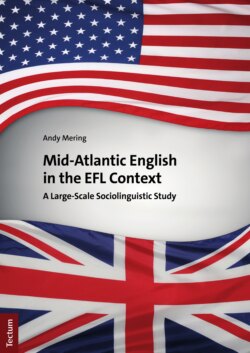Читать книгу Mid-Atlantic English in the EFL Context - Andy Mering - Страница 6
ОглавлениеTable of Contents
1. Introduction and Research Objective
2.6 A Novel Perspective in ELT
2.6.2 Mid-Atlantic English and Euro-English
2.6.2.2 The Variety Status of Euro-English
2.6.2.3 Standard Language Ideology
3. Standard British and Standard American English
3.2.1 A Brief Historical Overview
3.3 Contrasts in the Four Language Areas
3.3.1.1 A Classification Approach
3.3.1.2 A Dynamic Interrelationship
3.3.1.3 Archaic Features of American English
3.3.1.4 Innovative Features of American English
3.3.1.5 Former Americanisms in British English
3.3.2.2 Systematic Segmental Differences
3.3.2.3 Non-Systematic Segmental Differences
3.3.2.4 Suprasegmental Differences
3.3.3.4 Miscellaneous Differences
3.3.4 Spelling
3.3.4.1 Systematic Differences
3.3.4.2 Non-Systematic Differences
3.3.4.3 Non-Conventional Differences
3.3.5 Concluding Remarks
4. The Survey
4.1 Research Objectives
4.2 Method and Material
4.2.1 Requirements for Participant Recruitment
4.2.2 The Survey Participants
4.2.2.1 Upper Secondary Students
4.2.2.2 University Students of English Studies
4.2.2.3 Non-Native English Teachers
4.2.2.4 UK Native Speakers of English
4.2.3 The Questionnaires
4.2.3.1 Structure
4.2.3.2 Monitoring Attitudes to Accents
4.2.3.3 Monitoring Pronunciation
4.2.3.4 Selection Criteria for Variables
4.2.3.5 Exclusion of Variables
4.2.3.6 Mean Value Calculation
4.3 The Pilot Study
5. Survey Results
5.1 Upper Secondary Students
5.1.1 Demographic Information
5.1.2 Exposure to English
5.1.2.1 Visits to English-Speaking Countries
5.1.2.2 Extramural English Activities
5.1.2.3 Contact with English Speakers
5.1.3 Words
5.1.3.1 Overall Usages
5.1.3.2 Exclusive AmE Use
5.1.3.3 Use of Americanisms and Briticisms
5.1.3.4 Overall Findings
5.1.4 Lexico-Grammar
5.1.4.1 Overall Usages
5.1.4.2 Exclusive AmE Use
5.1.4.3 Use of Americanisms and Briticisms
5.1.4.4 Overall Findings
5.1.5 Spelling
5.1.5.1 Overall Usages
5.1.5.2 Exclusive AmE Use
5.1.5.3 Use of Americanisms and Briticisms
5.1.5.4 Overall Findings
5.1.6 Pronunciation
5.1.6.1 Monitored Variables
5.1.6.2 Reading
5.1.6.3 Overall Findings
5.1.7 Comparison of the Language Areas
5.1.8 Attitudes to British and American English
5.1.8.1 General Attitudes
5.1.8.2 Attitudes in the EFL Context
5.1.8.3 Attitudes to Six English Accents
5.1.8.4 Overall Findings
5.2 University Students of English Studies
5.2.1 Demographic Information
5.2.2 Exposure to English
5.2.2.1 Visits to English-Speaking Countries
5.2.2.2 Extramural English Activities
5.2.2.3 Contact with English Speakers
5.2.3 Words
5.2.3.1 Overall Usages
5.2.3.2 Exclusive AmE Use
5.2.3.3 Use of Americanisms and Briticisms
5.2.3.4 Overall Findings
5.2.4 Lexico-Grammar
5.2.4.1 Overall Usages
5.2.4.2 Exclusive AmE Use
5.2.4.3 Use of Americanisms and Briticisms
5.2.4.4 Overall Findings
5.2.5 Spelling
5.2.5.1 Overall Usages
5.2.5.2 Exclusive AmE Use
5.2.5.3 Use of Americanisms and Briticisms
5.2.5.4 Overall Findings
5.2.6 Pronunciation
5.2.6.1 Monitored Variables
5.2.6.2 Reading
5.2.6.3 Overall Findings
5.2.7 Comparison of the Language Areas
5.2.8 Attitudes to British and American English
5.2.8.1 General Attitudes
5.2.8.2 Attitudes in the EFL Context
5.2.8.3 The Future of English
5.2.8.4 Attitudes to Six English Accents
5.2.8.5 Overall Findings
5.3 Non-Native English Teachers
5.3.1 Demographic Information
5.3.2 Exposure to English
5.3.2.1 Visits to English-speaking Countries
5.3.2.2 Extramural English Activities
5.3.2.3 Contact with English Speakers
5.3.3 Words
5.3.3.1 Overall Usages
5.3.3.2 Exclusive AmE Use
5.3.3.3 Use of Americanisms and Briticisms
5.3.3.4 Overall Findings
5.3.4 Lexico-Grammar
5.3.4.1 Overall Usages
5.3.4.2 Exclusive AmE Use
5.3.4.3 Use of Americanisms and Briticisms
5.3.4.4 Overall Findings
5.3.5 Spelling
5.3.5.1 Overall Usages
5.3.5.2 Exclusive AmE Use
5.3.5.3 Use of Americanisms and Briticisms
5.3.5.4 Overall Findings
5.3.6 Pronunciation
5.3.6.1 Use of Individual Sounds
5.3.6.2 Use of Stress Patterns
5.3.6.3 Overall Findings
5.3.7 Comparison of the Language Areas
5.3.8 Attitudes to the Two Main Varieties
5.3.8.1 General Attitudes
5.3.8.2 Attitudes in the EFL Context
5.3.8.3 The Future of English
5.3.8.4 Overall Findings
5.4 UK Native Speakers of English
5.4.1 Demographic Information
5.4.2 Exposure to American English
5.4.3 Words
5.4.3.1 Overall Usages
5.4.3.2 Use of Americanisms and Briticisms
5.4.3.3 Overall Findings
5.4.4 Lexico-Grammar
5.4.4.1 Overall Usages
5.4.4.2 Exclusive AmE Use
5.4.4.3 Use of Americanisms and Briticisms
5.4.4.4 Overall Findings
5.4.5 Spelling
5.4.5.1 Overall Usages
5.4.5.2 Use of Americanisms and Briticisms
5.4.5.3 Overall Findings
5.4.6 Pronunciation
5.4.6.1 Use of Individual Sounds
5.4.6.2 Use of Stress Patterns
5.4.6.3 Overall Findings
5.4.7 Comparison of the Language Areas
5.4.8 Attitudes to the Two Main Varieties
5.4.8.1 General Attitudes
5.4.8.2 Attitudes to the Teaching of English
5.4.8.3 Overall Findings
5.5 Comparison of the Four Informant Groups
5.5.1 Comparative General Overview
5.5.2 Discussion
6. Varieties of English in EFL Teaching
6.1 World Englishes and the Task-based Approach
6.1.1 Raising Awareness of the Diversity of English
6.1.2 Reflecting on the Use of English
6.1.3 Exploring Different Non-Native Varieties of English
6.1.4 Discovering Varieties of English on the Internet
6.1.5 Presenting Results from Group Work and Projects
6.1.6 Discussing the Relevance of Diversity
6.1.7 Appropriating Interaction Strategies
6.1.8 Raising Awareness of Other Cultures
6.1.9 Concluding Remarks
6.2 American English in EFL Teaching Materials
6.2.1 Course Books
6.2.2 Spotlight English Language Magazine
6.2.3 Grammar Reference Books
6.2.4 Concluding Remarks
7. Conclusion and Outlook
8. Bibliography
9. Appendices
9.1 Reading Text for Upper Secondary Students
9.2 Reading Text for Students of English Studies
